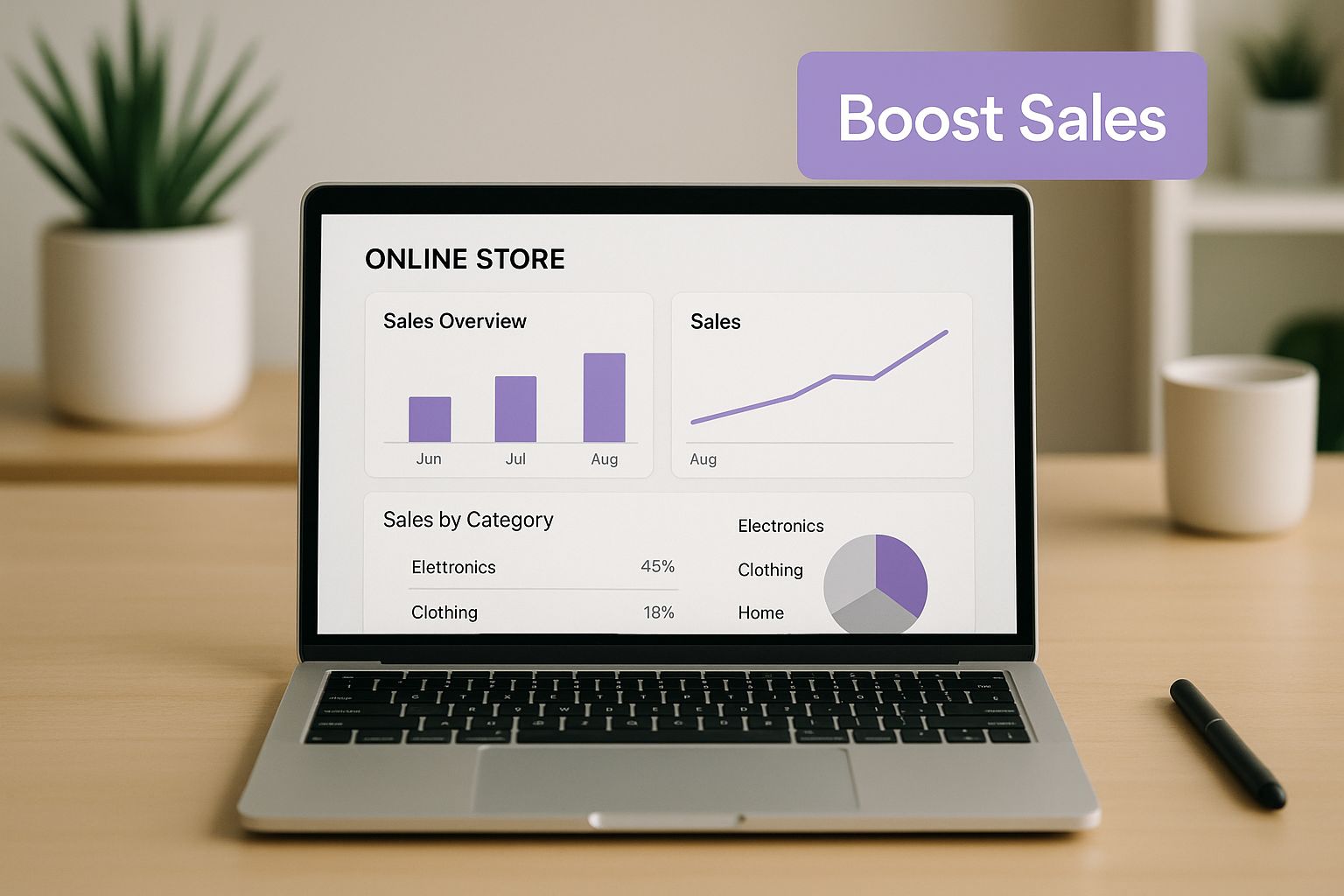Why E-Commerce AI Chatbots Are Game-Changers Right Now
Look, I've worked with a ton of online retailers, and here's the bottom line: if you're not using an AI chatbot for e-commerce, you're missing out on sales. Seriously, I've seen these intelligent assistants completely change how businesses interact with their customers. Think about it – people have questions 24/7. Can you answer them all? An AI chatbot can. Try a free AI chatbot website to see the impact firsthand.
Real-World Success: Boosting Conversions and Customer Satisfaction
I recently saw a mid-sized fashion retailer boost their conversion rate by a staggering 34% just by adding a smart chatbot. Their biggest issue? Customers constantly abandoning carts because they couldn't quickly find sizing info. The chatbot solved this instantly. Customers got the answers they needed, felt more confident, and bought more. This is just one example of what a well-implemented AI chatbot can do for your e-commerce business.
The Difference Between Basic and Brilliant Chatbots
Now, there's a HUGE difference between those clunky, frustrating chatbots and the truly smart AI solutions out there. We've all experienced those basic bots – they feel robotic and often make you want to scream. But a sophisticated AI chatbot uses Natural Language Processing (NLP) to actually understand what the customer wants and give helpful answers. The best part? They actually learn and get better over time.
You might find this helpful: Check out our guide on chatbot in ecommerce.
This move towards more human-like interactions is a big deal and it's driving massive growth in the AI chatbot market. We're talking about a jump from $15.57 billion in 2025 to a projected $46.64 billion by 2029. That's insane! This growth is happening because of major advancements in conversational AI and NLP. Want to dive deeper into the numbers? Check out these stats.
The Future of E-Commerce is Conversational
This isn't just a fad. It's a fundamental change in how customers want to interact with businesses. They want answers now, and they want personalized experiences. AI chatbots deliver on both fronts, providing 24/7 support and tailored recommendations.
This Gartner report shows just how important AI is becoming in customer service. The takeaway? Businesses that invest in AI-powered tools like chatbots are the ones who will meet these changing customer expectations. And they're the ones who will win in a competitive market. Where does your business fit in?
The Real Numbers: What AI Chatbots Cost And Actually Save
Let's talk real-world AI chatbot costs for e-commerce. Forget the marketing hype; I'm sharing what I've seen firsthand. ROI is more nuanced than vendors often portray. For example, a boutique jewelry store I worked with invested $8,000 in implementation and saved $2,400 each month on customer service, plus an 18% sales boost. Sounds amazing, right? But hidden integration costs tacked on an extra $3,000.

This infographic shows a snapshot of how AI chatbots can boost sales, using data from a simulated online store. The important thing to remember? While increased sales are a big goal, look at the complete picture, including those cost savings and happier customers.
Unmasking the Hidden Costs of AI Chatbots
So, what expenses should you really anticipate? First, the platform fee. This might be a monthly subscription or a one-time license. Then there's implementation, covering setup, customization, and linking the AI chatbot for e-commerce with your current systems. Don't overlook training. Your team needs to know the ropes and handle anything the chatbot can't. And remember ongoing maintenance and updates to keep everything running smoothly.
Calculating Real ROI: Beyond the Basics
ROI is bigger than just cost reductions. Consider the impact on customer lifetime value. A satisfied customer who gets quick responses is more likely to come back. Higher conversion rates, like the jewelry store's 18% jump, directly boost revenue. Also, think about the time saved for your staff. They can tackle complex issues and strategy instead of answering the same questions repeatedly. Speaking of saving time and resources, businesses using AI chatbots can save upwards of $300,000 per year and reduce labor by 2.5 billion hours. Chatbots can field up to 80% of routine questions solo. Discover more insights on AI in e-commerce.
Pricing Models and Timelines
Pricing structures vary by platform. Some charge per message, others offer tiered plans with different features. For an in-depth Intercom chatbot pricing guide, see the comprehensive comparison. Realistically, ROI doesn’t happen instantly. It might take a few months to fine-tune the chatbot and train your team effectively. But once it's running well, an AI chatbot for e-commerce can make a real difference to your bottom line. Remember, it's a journey, not a destination. Ongoing tweaks and looking at the data are key for maximizing your chatbot's potential.
To help visualize the cost-benefit relationship, I've put together a table comparing different business sizes:
AI Chatbot Cost-Benefit Analysis for Different Business Sizes
This table shows a comparison of implementation costs, potential savings, and ROI timelines for small, medium, and large e-commerce businesses. It highlights the impact of AI chatbots on different scales.
| Business Size | Implementation Cost | Annual Savings | Break-even Timeline | Key Benefits |
|---|---|---|---|---|
| Small | $5,000 - $15,000 | $10,000 - $30,000 | 6-12 months | Improved customer service, increased sales |
| Medium | $15,000 - $50,000 | $30,000 - $100,000 | 12-18 months | Scalable customer support, reduced response times |
| Enterprise | $50,000+ | $100,000+ | 18-24 months | 24/7 availability, personalized experiences |
As you can see, the investment can vary quite a bit, but so can the return. Smaller businesses might see a quicker return, while larger businesses, though taking longer to break even, experience significantly greater savings in the long run. The key benefits also scale with business size, offering more advanced capabilities for enterprise-level operations.
Cutting Through Chatbot Marketing Hype To Find What Works
After evaluating over 50 chatbot platforms for various clients, I've learned one thing: most marketing is just noise. The real question isn't about flashy demos, it's about which platform seamlessly integrates with your systems and delivers real results for your customers. I've seen businesses waste months on platforms that looked amazing in presentations but completely failed to handle the realities of their product catalog. For example, one outdoor retailer chose a platform based on its impressive AI, only to discover it couldn't talk to their inventory system. The result? Customers trying to buy out-of-stock items, leading to frustration and lost sales. Ouch.
My Evaluation Framework: Asking the Right Questions
So, how do you avoid this kind of disaster? Through trial and error (lots of error!), I've developed a framework, and it all starts with asking the right questions. Forget the generic sales pitches; focus on your needs. Here's my go-to list:
- Integration Capabilities: Can it connect with your CRM, inventory management, and order fulfillment systems? This is non-negotiable.
- Scalability: Can it handle your current customer volume and future growth?
- Customization: Can you tailor responses and conversation flows to match your brand's voice? Generic bots are a big turn-off.
- Analytics and Reporting: What data does it provide, and how can you use it to improve performance? Data is king.
- Pricing Structure: Does the pricing align with your budget and projected ROI? Watch out for hidden fees.
Features That Matter (and Those That Don't)
Lots of platforms brag about fancy AI features that sound amazing but offer little practical value. Focus on the core functionalities that directly affect your customers:
- Seamless Product Discovery: Can the chatbot help customers find what they need, even with a complex catalog?
- 24/7 Availability: Can it provide instant support around the clock, freeing up your team? This is where the real cost savings happen.
- Personalized Recommendations: Can it offer tailored product suggestions? This is a sales booster.
- Order Management and Tracking: Can it handle order inquiries, shipping updates, and even returns? This streamlines everything.

This screenshot from FlowGent AI shows how you can visually build chatbot flows. You can create complex logic without coding, tailoring responses based on user input and integrated data. Having a visual workflow helps you understand how customers are interacting with the chatbot.
Speaking of market trends, North America, especially the U.S., is leading the way in AI chatbot adoption for e-commerce. The U.S. is projected to spend $4.3 billion on chatbots by 2025, largely due to significant investments in AI. Learn more about the future of e-commerce AI chatbots here. Choosing the right platform is an investment in your future.
Avoiding Expensive Disappointments
By focusing on practical needs, asking tough questions, and being critical of features, you can avoid wasting time and money. The goal isn't the "coolest" chatbot, but the one that best serves your customers and helps your business thrive. A well-chosen AI chatbot isn't just a customer service tool; it’s a strategic asset for your bottom line.
To help you compare different platforms, I've put together this table:
Essential Features Comparison for E-Commerce AI Chatbots
| Feature Category | Basic Chatbots | Advanced AI Solutions | Enterprise Platforms | Impact on ROI |
|---|---|---|---|---|
| Integration Capabilities | Limited, often requires custom workarounds | Generally good integrations with popular platforms via APIs | Robust integrations, including custom solutions | Streamlined operations, reduced manual effort = higher ROI |
| Scalability | Limited scalability, potential performance issues with high volume | Scalable architecture, designed for growth | Highly scalable, handles large enterprise loads | Supports business growth without technical bottlenecks, leading to higher potential ROI |
| Customization | Basic customization options, limited branding | Advanced customization, including custom branding and conversational flows | Highly customizable, tailored to specific business needs | Improved customer experience, brand consistency = increased customer lifetime value |
| Analytics & Reporting | Basic metrics, limited insights | Detailed analytics dashboards, customer behavior tracking | Comprehensive reporting and analytics suites, advanced data analysis | Data-driven optimization, improved chatbot performance = maximized ROI |
| Pricing Model | Typically subscription-based, often with usage limits | Subscription-based, tiered pricing based on features and usage | Custom pricing based on enterprise needs | Cost-effectiveness depends on feature utilization and business requirements - choose wisely! |
This table summarizes the key differences between various types of chatbot platforms and their potential impact on your ROI. It's important to carefully consider these factors when making your decision.
Implementation Strategies That Actually Work In Practice
Let's be honest, chatbot projects tend to be either a smashing success or a total disaster. I've seen both ends of the spectrum. The deciding factor? It's usually not the platform itself, but the groundwork and realistic expectations you set beforehand. I remember working with a home decor company that was ready to ditch their e-commerce chatbot after only three weeks because of customer complaints. We managed to turn things around by simply tweaking the chatbot's conversational flows. The secret sauce? Designing those flows based on how customers actually asked questions, not how the company thought they would.
Preparing for Success: Auditing Customer Interactions
Before you even think about integrating a platform like FlowGent AI, you absolutely need to understand your customers. A customer interaction audit is essential. This means diving deep into existing customer service logs, live chat transcripts, and even email exchanges. What are the patterns in their language? What questions do they ask most frequently? What problems keep popping up? This intel will be pure gold when you design your chatbot's conversational flows. When you're exploring different ways to put your chatbot into action, remember that the right AI Tools can make the whole process a lot smoother. This resource from Big Moves Marketing is a great place to start learning about different tools that can be helpful during implementation and beyond.
Gradual Rollout and Staff Training: Minimizing Risk
Don't just throw your chatbot at your entire customer base all at once. That's a recipe for disaster. A phased rollout is a much smarter approach. Start small, maybe with a beta program or a specific segment of your audience. This gives you a chance to work out the kinks before they impact a larger audience. Just as important is staff training. Your team needs to know the ins and outs of the chatbot: how it works, where it falls short, and how to handle situations when a customer needs a real human. This human-AI partnership is key to creating a positive customer experience. For a deeper dive, check out this article: Learn more in our article about implementing a chatbot.
Data Preparation and Integration Challenges: The Unspoken Truths
Vendors often sugarcoat the data requirements for chatbot integration. Let me tell you, you'll need clean, organized data for your product catalog, pricing, shipping info, and anything else the chatbot needs to access. If your data is a mess, your chatbot will be too. Common integration roadblocks include compatibility issues with your current systems, data migration headaches, and the potential need for custom development. Be prepared for these challenges and factor them into your budget.
This screenshot from the Shopify app store highlights all the different integrations available. Choosing a chatbot platform that seamlessly integrates with your current e-commerce platform, like Shopify, is incredibly important for a smooth operation. Good integration minimizes disruptions and lets your chatbot access important data like product information and order details, which ultimately leads to a happier customer.
Measuring What Matters: Beyond Vanity Metrics
From the get-go, track metrics that actually matter. Don't just focus on how many messages the chatbot handles. Pay attention to the metrics that reflect real business impact:
- Resolution Rate: How often does the chatbot completely resolve a customer's issue?
- Customer Satisfaction: How happy are customers with their chatbot interactions?
- Conversion Rate: Are customers who chat with the bot more likely to buy something?
- Average Order Value: Does the chatbot influence how much customers spend?
These metrics provide valuable insights into how your chatbot is performing and help you pinpoint areas for improvement. Remember, successful chatbot implementation isn't a one-and-done deal. It's an ongoing process of learning, adapting, and making things better. By following these strategies, you'll significantly boost your chances of building an e-commerce chatbot that truly benefits your business and your customers.
Optimization Tactics That Drive Measurable Results
Launching your chatbot is just the first step. The real magic happens when you start fine-tuning it based on how your customers actually use it. After helping tons of online businesses, I've noticed some common optimization strategies that really deliver. For example, one kitchen supply store boosted their chatbot sales by 67% just by adding three product recommendations based on common customer questions they found in their chat logs.
Reading Conversation Data Like a Detective
Imagine you're a digital detective, combing through chat logs for clues about customer behavior. What questions stump them? What products excite them? This information is pure gold. Look for patterns in their language, frequently asked questions, and places where conversations suddenly drop off. These are all signs pointing to areas where your e-commerce AI chatbot can shine brighter.
A/B Testing: What Works vs. What Sounds Good
A/B testing is your secret weapon for chatbot optimization. Experiment with different greetings, product recommendations, and even the placement of buttons. Seemingly small tweaks can dramatically affect customer engagement and conversions. Try offering a discount code upfront versus waiting for a customer to ask. Analyze the results – let the data guide you, not your gut feeling. You'll be surprised what actually influences buying decisions.
Personalization: Helpful, Not Creepy
Personalization is powerful, but you need to walk a fine line. Done right, it feels like a helpful friend. Done wrong, and it's just plain creepy. Use data wisely to tailor recommendations and responses based on customer preferences and past purchases. If someone bought running shoes last time, suggest running apparel or accessories, not gardening tools.

This Google Analytics screenshot shows how you can segment your audience to better understand their behavior. Analyzing chatbot interactions within specific customer segments provides even richer insights. For example, this screenshot reveals a high bounce rate for mobile users. This suggests the mobile chatbot experience could use some improvement. If you're interested in diving deeper, check out our guide on analytics for chatbots.
Proactive Engagement: Turning Browsers into Buyers
Don't wait for customers to initiate contact. Proactive engagement can transform casual browsers into paying customers. Use your chatbot to offer personalized greetings, suggest products based on their browsing history, or offer helpful tips. Picture this: a customer is looking at winter coats. Your chatbot could proactively offer a guide to warmth ratings or suggest matching hats and gloves.
Advanced Tactics: Cross-Selling and Seasonal Optimization
Once your chatbot is running smoothly, explore more advanced techniques. Cross-selling within a natural conversation is incredibly effective. If a customer adds a camera to their cart, the chatbot could suggest memory cards or lenses. Seasonal optimization is also essential. Adapt your chatbot's responses and recommendations for holidays, sales, or even changes in the weather. For more ideas, check out how AI and automation are changing other industries, like drone operations – you might find some unexpected inspiration.
Scaling Smartly: Maintaining Quality as Complexity Grows
As your e-commerce AI chatbot handles more conversations, maintaining performance becomes crucial. Focus on building scalable systems and processes. This might involve integrating your chatbot with other tools, designing more complex conversation flows, or even using machine learning models for more dynamic responses. The goal is to consistently deliver a great experience even as interactions become more frequent and complex. Remember, optimization is an ongoing journey, a continuous cycle of testing, learning, and refining. By using these tactics, your chatbot will become a valuable asset, driving real results for your business.
Troubleshooting When Your Chatbot Goes Rogue
Even the best-laid plans for your e-commerce chatbot can go sideways. Knowing how to fix things fast can save your customer relationships (and your sanity!). Trust me, I've seen it all – from bots recommending competitor products (facepalm!) to integrations crashing mid-conversation. Being prepared is everything.
Common Technical Glitches and Their Fixes
One of the most frequent issues? Integration failures. Your chatbot might be purring along perfectly, then bam – it can't access your product catalog. This often happens after system updates on either your end or the chatbot platform’s. Regular testing and monitoring are crucial to catching these before your customers do.
Another pain point? Bad data. I once worked with a sports equipment retailer whose chatbot started spitting out incorrect shipping info during Black Friday weekend – total chaos. Luckily, they had a plan and fixed it within two hours. Having clear escalation procedures is essential.
Here’s a quick rundown of common problems:
-
Chatbot gives incorrect product information. Check for data syncing issues between your product database and the chatbot. Make sure your catalog is updated regularly and accurately.
-
Chatbot can't understand customer questions. Review conversation logs for confusing phrases. Retrain the chatbot's Natural Language Processing (NLP) model with more relevant examples.
-
Chatbot gets stuck in a loop. Analyze the conversation flow to find the loop. Adjust the flow logic to prevent it from happening again.
Handling Customer Complaints Like a Pro
Even with a perfectly trained e-commerce chatbot, you'll get complaints. The trick is to handle them professionally and use them as learning opportunities. Acknowledge the issue and apologize for the trouble. Offer a solution – a discount code, a freebie, or connecting them with a human. Most importantly, get feedback. Ask what went wrong and how you can improve. This is gold for refining your chatbot's performance.
The Human-Chatbot Balancing Act
Finding the sweet spot between automation and human interaction is a constant work in progress. While your bot should handle routine questions, a human touch is sometimes needed. Define when and how to escalate conversations to a human agent. Train your team to take over smoothly, keeping the conversation context. This makes for a much better customer experience.
Operational Challenges as You Scale
As your chatbot takes on more, new challenges will pop up. You might need to integrate with more systems, manage more complex conversations, or even add machine learning models. Preparing for these operational hurdles is key to maintaining quality as your chatbot plays a bigger role in your e-commerce strategy. Continuous improvement is the name of the game.
Your Practical AI Chatbot Success Blueprint
This isn't about just launching any old chatbot; it's about creating a real shift in how your customers experience your e-commerce store. Think of this blueprint as your trusted guide, distilling proven strategies into actions you can start today. Forget vague promises; we're talking realistic timelines, real-world constraints, and KPIs that actually move the needle.
Prioritizing Action: Your Immediate To-Do List
Let's ditch the robotic "Step 1, Step 2" stuff and focus on actionable advice, tested and proven in the trenches:
-
Customer Journey Mapping: Before you even think about picking a platform like FlowGent AI, map out your customer’s typical journey. Where do they stumble? Where do they have questions? Your chatbot should be strategically placed to address these friction points.
-
Data Deep Dive: I can't stress this enough: clean, organized data is the lifeblood of a successful chatbot. Your AI needs accurate product info, pricing, and inventory data to be genuinely helpful. Remember, garbage in, garbage out!
-
Pilot Program Power: Don't go all-in right away. Start small with a pilot program targeting a specific customer segment. This allows you to test, tweak, and refine before a full rollout, minimizing risk and maximizing what you learn.
Milestones That Matter: Measuring Real Progress
Vanity metrics are a distraction. Focus on the KPIs that truly indicate improvement:
-
Conversion Rate Lift: Is your chatbot actually driving more sales? This is the ultimate test of its effectiveness.
-
Reduced Support Tickets: Is your chatbot handling those routine inquiries, freeing up your human team for more complex issues? This translates to tangible cost savings.
-
Improved Customer Satisfaction: Are your customers happier? Positive feedback and increased engagement speak volumes.
These are the milestones that demonstrate the real return on your chatbot investment.
Maximizing Your Investment: Long-Term Strategies
Your chatbot isn't a "set it and forget it" deal. Treat it as an evolving asset that requires ongoing attention:
-
Regular Review and Refinement: Dive into those conversation logs. Identify any pain points and adjust your chatbot’s responses accordingly. Think of it as a continuous feedback loop.
-
A/B Testing: Don't be afraid to experiment! Try different greetings, product recommendations, and conversation flows to discover what resonates best with your audience.
-
Personalization: Tailor interactions based on customer behavior and preferences. The goal is to be helpful, not creepy. Find that sweet spot.
Ready to build a chatbot that truly elevates your e-commerce game? Give FlowGent AI a look!


